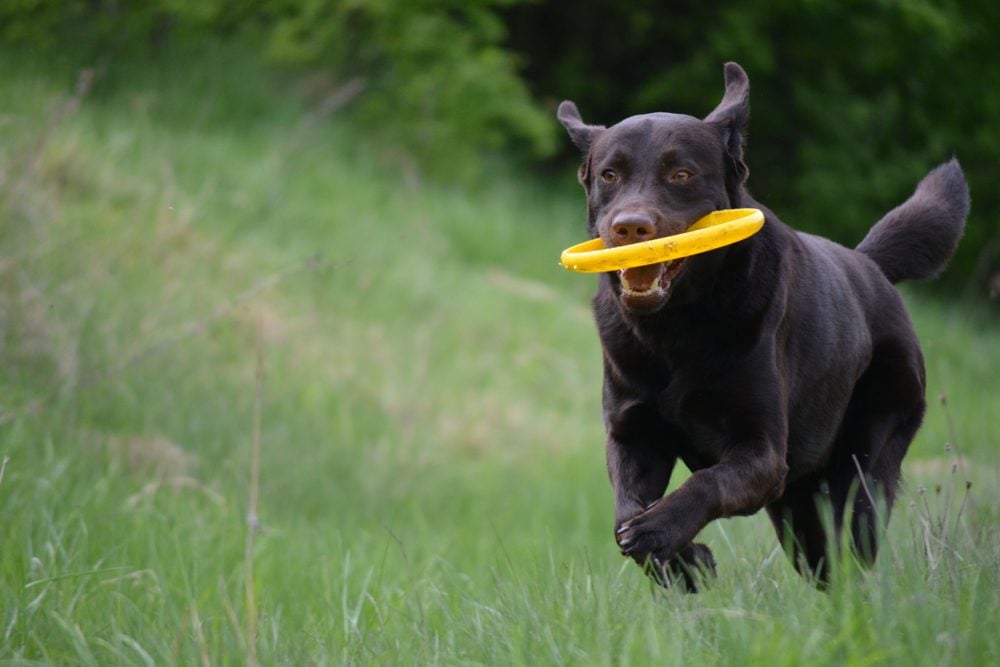Contemplating a chocolate Labrador Retriever? Wondering if they're easy to train? With their lovable personalities and popular coat colors, chocolate Labs stand out among dog breeds. Are Chocolate Labs easy to train? The answer lies in their intelligence and willingness to please, making them generally responsive to training. While individual differences exist, their adaptable nature often makes the training process smoother.
Consistent positive reinforcement, treats, and a patient approach contribute to their success. As a popular choice for families, the effort invested in training pays off with a well-behaved and affectionate companion. So, if you're considering a chocolate Lab, rest assured, with the right techniques, training them can be a rewarding experience. Are Chocolate Labs easy to train? Find out as you embark on a delightful journey with this charming and trainable breed.

Characteristics of Chocolate Labs
Chocolate labs, like their black and yellow counterparts, are known for their friendly and outgoing nature. They are intelligent and eager to please, which makes them a joy to train. Their high energy levels and natural athleticism also contribute to their trainability. Whether you're teaching them basic obedience or advanced tricks, chocolate labs are quick learners.
However, it's essential to remember that each chocolate lab is an individual with a unique personality. While most chocolate labs are easy to train, some may be more independent or stubborn than others. Understanding your dog's temperament and tailoring your training methods accordingly will help you achieve the best results.
Factors that affect trainability
While chocolate labs are generally easy to train, several factors can affect their trainability. The first factor is their age. Starting training from a young age is crucial as it helps establish good habits early on. Puppies have a natural curiosity and are more receptive to learning. By introducing basic commands and positive reinforcement at an early stage, you set the foundation for a well-behaved adult chocolate lab.

Another important factor is consistency. Dogs thrive on routine, so it's important to establish consistent training sessions. This includes the timing, duration, and frequency of training. Reinforcing the same commands and behaviors consistently will help your chocolate lab understand what is expected of them.
The third factor is the training environment. Distractions can make it challenging for chocolate labs to focus on their training. It's important to start training in a quiet and controlled environment before gradually introducing distractions. This allows your chocolate lab to build up its focus and concentration gradually.
Training techniques for Chocolate labs
Training chocolate labs requires a positive approach, emphasizing rewards and reinforcement. These dogs respond exceptionally well to praise, treats, and positive outcomes, establishing a connection between good behavior and rewards. The efficacy of clicker training, a popular technique for chocolate labs, lies in a handheld device emitting a distinctive click upon correct behavior, offering instant feedback and reinforcement.
Consistency and patience are paramount in chocolate lab training. The process demands time and effort, necessitating unwavering patience and persistence. Consistent application of training methods and expectations is crucial for helping your chocolate lab comprehend and meet the required behavior standards.

Positive reinforcement, encompassing praise, treats, and rewards, forms the foundation of effective chocolate lab training. By associating desirable behaviors with positive outcomes, you create a motivational environment for continuous learning.
Clicker training, with its distinctive sound marker, enhances communication with your chocolate lab. This method offers instant feedback, aiding your dog in understanding which actions warrant rewards. Integrating clicker training into your routine further refines the training experience.
In conjunction with positive reinforcement and clicker training, maintaining consistency is essential. Your chocolate lab thrives on routine, and consistent expectations reinforce understanding. Patience is equally vital; as you invest time and effort in training, persistence pays off in a well-behaved and responsive companion.
In summary, successful chocolate lab training necessitates a positive reinforcement approach, encompassing praise, treats, and rewards. Clicker training, with its distinctive marker, enhances communication, providing instant feedback. Consistency and patience round out the equation, ensuring a well-behaved chocolate lab that responds to your cues with enthusiasm.
Basic obedience training for chocolate labs
Basic obedience training is an essential part of any dog's training journey, and chocolate labs are no exception. Teaching your chocolate lab basic commands such as sit, stay, come, and down will help establish a strong foundation for further training.
To start, choose a quiet and distraction-free area for training. Use treats or toys as rewards and keep training sessions short and focused. Begin with one command at a time, using positive reinforcement and repetition to reinforce the desired behavior. As your chocolate lab becomes more proficient, gradually increase the difficulty level and introduce new commands.
Consistency is key in basic obedience training. Ensure that everyone in the household uses the same commands and rewards, as consistency helps your chocolate lab understand what is expected of them. Regular practice and reinforcement will help solidify these commands in your dog's mind.
Advanced training for chocolate labs
Once your chocolate lab has mastered basic obedience training, you can move on to more advanced tasks and tricks. Advanced training not only challenges your dog mentally but also strengthens the bond between you and your furry companion.

One popular advanced training activity for chocolate labs is agility training. This involves navigating a course of obstacles such as jumps, tunnels, and weave poles. Agility training helps improve your dog's coordination, speed, and focus. It also provides mental stimulation and physical exercise, making it a great option for high-energy chocolate labs.
Another advanced training option is scent work. Chocolate labs have an exceptional sense of smell, and harnessing this ability through scent work can be both mentally stimulating and rewarding. Teaching your chocolate lab to identify and locate specific scents can be a fun and engaging activity for both of you.
Remember to break down advanced training tasks into smaller, achievable steps. Use positive reinforcement and rewards to motivate your chocolate lab and celebrate their progress along the way.
Problem-solving training for chocolate labs
Problem-solving training is an important aspect of a well-rounded training program for chocolate labs. This type of training helps your dog develop critical thinking skills, adaptability, and problem-solving abilities.
One problem-solving training exercise for chocolate labs is food puzzles. These puzzles require your dog to figure out how to access hidden treats by manipulating different parts of the puzzle. Food puzzles provide mental stimulation and encourage your chocolate lab to think and problem-solve.
Another problem-solving training activity is teaching your chocolate lab to find hidden objects or toys. Start with simple hiding spots and gradually increase the difficulty level. This exercise taps into your dog's natural hunting instincts and provides mental stimulation.
Problem-solving training can be a fun way to challenge your chocolate lab while providing mental stimulation and enrichment.

Training tips for Chocolate Lab owners
Here are some additional tips to help you make the most of your training sessions with your chocolate lab:
- Be patient: Training takes time and consistency. It's important to remain patient and avoid getting frustrated. Your chocolate lab will pick up on your emotions, so maintaining a positive and calm demeanor is essential.
- Keep sessions short: Dogs have short attention spans, so it's important to keep training sessions short and focused. Aim for multiple short sessions throughout the day rather than one long session.
- Use positive reinforcement: Rewarding your chocolate lab with treats, praise, and affection reinforces positive behavior. This encourages your dog to continue learning and improves their overall motivation.
- Be consistent: Consistency is crucial in training. Use the same commands, rewards, and training techniques consistently to help your chocolate lab understand what is expected of them.
- Seek professional help if needed: If you're facing challenges or struggling with training, don't hesitate to seek professional help. A qualified dog trainer can provide guidance and support tailored to your chocolate lab's specific needs.
Common challenges in training chocolate labs
While chocolate labs are generally easy to train, like any other dog breed, they can present some challenges. One common challenge is their high energy levels. Chocolate labs are known for their boundless energy, which can make it difficult to keep them focused during training sessions. Ensuring they receive sufficient exercise and mental stimulation before training can help alleviate this challenge.
Another challenge is their natural inclination to explore and follow their noses. Chocolate labs have a strong sense of smell and may become easily distracted by scents in their environment. It's important to gradually introduce distractions during training sessions and build up your chocolate lab's focus and concentration.
Lastly, some chocolate labs may exhibit stubbornness or independence, which can make training more challenging. Tailoring your training techniques to suit your dog's personality and providing clear boundaries and expectations can help overcome this challenge.

Conclusion
In conclusion, chocolate labs are generally easy to train due to their intelligence, eagerness to please, and natural athleticism. With the right approach, consistency, and positive reinforcement, these dogs can excel in obedience training, tricks, and even more advanced tasks.
Accounting for the unique temperament of your chocolate lab is crucial. Some may display independence or stubbornness, necessitating extra patience and tailored training techniques. Initiating training early and instilling positive habits from the start is pivotal for success.
Training is an evolving journey, influenced by love, patience, and consistency. Individualized approaches may be needed to address the distinct traits of your chocolate lab. Recognizing that training is an ongoing process ensures adaptability to your dog's needs.
Starting the training process from puppyhood establishes a foundation for well-behaved habits. Patience becomes a virtue as you navigate the nuances of your chocolate lab's personality, fostering a strong and trusting relationship. Embrace the journey, savor the moments of growth, and revel in the deep bond forged between you and your loyal, furry companion.
FAQs
- Are chocolate Labs easy to train compared to other dog breeds?
- Yes, chocolate Labrador Retrievers are generally considered easy to train compared to many other dog breeds. This ease of training is due to their high intelligence, eagerness to please, and their strong desire to work with humans. Labs are known for their quick learning ability and responsiveness to positive reinforcement techniques.
- What makes chocolate Labs good at training?
- Chocolate Labs excel in training due to a combination of traits including intelligence, a good temperament, and a strong willingness to please their owners. They are naturally sociable and cooperative, making them receptive to learning and following commands. Their intelligence enables them to understand and remember commands easily.
- At what age should I start training my chocolate Lab?
- Training should start as soon as you bring your chocolate Lab puppy home, typically around 8 weeks of age. Early training and socialization are crucial for developing good behavior and obedience. Start with simple commands and gradually progress as your puppy grows and learns.
- What are the best training methods for chocolate Labs?
- Positive reinforcement is the most effective training method for chocolate Labs. This involves rewarding good behavior with treats, praise, or playtime. Consistency in commands and rewards is key. Avoid harsh disciplinary methods, as they can lead to fear and mistrust.
- How long does it take to train a chocolate Lab?
- The duration of training a chocolate Lab varies depending on the specific training goals and the individual dog. Basic obedience training, such as sit, stay, and come, can be taught within a few weeks. More complex skills and behaviors may take several months to a year of consistent training.
- Can chocolate Labs be trained for specific roles or activities?
- Yes, chocolate Labs are versatile and can be trained for various roles, including service dogs, therapy dogs, hunting companions, and participants in dog sports. Their adaptability and trainability make them suitable for a wide range of specialized tasks.
- What are common training challenges with chocolate Labs?
- Common challenges include distraction due to their high energy levels and curiosity, stubbornness in adolescence, and a tendency to get overexcited. Consistent training, adequate exercise, and patience are key to overcoming these challenges.
- Are chocolate Labs suitable for first-time dog owners?
- Chocolate Labs are often recommended for first-time dog owners due to their trainable nature and friendly disposition. However, potential owners should be prepared for their high energy levels and need for regular exercise and mental stimulation.




